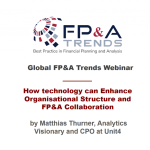Integrated FP&A involves harmonising the three levels of planning - Strategic, Financial and Operational levels. This is...

Are you tired of using outdated processes and relying solely on Excel for forecasting and planning? In today's fast-paced business landscape, traditional methods can hinder your ability to make informed decisions due to their lack of adaptability. Shockingly, according to the global FP&A Trends survey, 52% of respondents still use Excel as their primary planning system, resulting in over 45% of wasted time on low-value tasks such as data collection and validation. To stay ahead, FP&A teams must embrace flexible and dynamic processes and modern technologies. This article explores the practical benefits of balanced processes and technologies in FP&A to help you level up your playbook and make informed decisions with confidence.
FP&A: Process or Technology?
In FP&A, the debate often centres on whether to prioritise process or technology. While both are essential, it's crucial to establish your processes first to identify areas for improvement and find the right technology to support them. This approach ensures that your technology investment supports your processes and helps you achieve your FP&A goals.
There are several critical FP&A processes, such as planning, forecasting, budgeting and analysis. However, in today's ever-changing business environment, one process that stands out as particularly important is scenario management. By creating and evaluating different scenarios, organisations can be better prepared to navigate uncertainty and make informed decisions that keep them on track to achieve their goals.
Three Critical Elements of the Effective FP&A Process
The most effective FP&A processes share three critical elements: collaboration, integration and agility. Let's dive into why each element is essential to success.
First, collaboration is key. Involving stakeholders in the forecasting process helps create accurate scenarios. Input from marketing, sales and operations, for instance, can provide valuable insights into customer feedback and campaign effectiveness. This approach results in forecasts that reflect the organisation's overall goals and objectives.
Second, integration is essential to ensuring consistency and accuracy. When all team members work from the same data, forecasts are more reliable. For instance, integrating data from multiple sources can lead to informed decision-making when analysing the impact of interest rate changes.
Finally, agility is crucial in a fast-paced business environment. By adapting quickly and updating scenarios in real time, FP&A teams can make better decisions and respond promptly to unexpected changes. For instance, updating scenarios on the fly can help FP&A teams adjust their plans when new competitors enter the market.
Together, these three elements create a robust and effective FP&A process supporting the organisation's strategic objectives. By prioritising collaboration, integration and agility, FP&A teams can provide valuable insights that drive the business forward.
Best-in-Class FP&A Process: Five Practical Steps for Consideration
To implement a best-in-class FP&A process, you can take practical steps to connect people and data. Here are some steps to ensure success:
1. Review your current planning and forecasting processes to identify gaps and streamline the process for efficiency.
2. Establish a cross-functional team that includes stakeholders from different departments to create more comprehensive and accurate forecasts.
3. Identify the key business drivers using the Pareto principle to prioritise the most important drivers.
4. Develop and implement a dynamic forecasting driver-based model that allows for real-time updates and enables agility, collaboration and integration.
5. Educate people on the integrated models, methods and purposes to streamline and improve the forecasting process.
Once these steps are in place, consider using technology to enhance your FP&A process. Choose technology that is self-service, analytical, easy to manage and adaptable to your process and industry. By using modern technology to connect people and data, you can achieve the best-in-class FP&A process that supports your organisation's strategic objectives.
Empowering FP&A with Cloud-based Solutions and AI/ML Capabilities
Modern technology is transforming FP&A, providing businesses with numerous benefits. However, adopting new technology without updating underlying processes can create more problems than it solves. Therefore, modern FP&A technology needs to be based on collaborative, integrated and agile processes to realise its full potential. Here are the top four benefits of modern FP&A technology:
1. Improved Efficiency: Automating time-consuming tasks, such as data collection, validation and consolidation, cloud-based solutions, and AI/ML capabilities free up time for more valuable tasks, allowing FP&A teams to focus on strategic initiatives.
2. Enhanced Agility and Responsiveness: Modern technology provides real-time insights and helps identify hidden trends and patterns, enabling FP&A teams to adapt quickly to changing business conditions.
3. More Accurate Forecasting and Planning: Integrated planning tools with AI/ML capabilities enable FP&A teams to analyse data in greater detail, resulting in more accurate forecasting and budgeting.
4. Analytical Insights: Modern FP&A technology provides analytical insights that help businesses optimise costs, improve financial performance and drive growth.
For instance, a manufacturing company uses a cloud-based solution with AI/ML capabilities to automate their forecasting process, gaining insights into raw material availability and production capacity. Similarly, an e-commerce business adopts an integrated planning tool with AI/ML capabilities to adjust staffing and marketing strategies based on changing consumer behaviour, improving its bottom line.
Conclusions
Modern FP&A technology is transforming the finance world, offering numerous benefits such as enhanced agility, accurate forecasting and analytical insights. But it's important to implement it, focusing on collaboration, integration and agility. By doing so, businesses can unlock the full potential of modern FP&A technology, make informed decisions and stay ahead of the curve. The key to success in today's fast-paced business landscape lies in balancing technology and efficient processes.
This article was first published on the SAP Blog.
Subscribe to
FP&A Trends Digest

We will regularly update you on the latest trends and developments in FP&A. Take the opportunity to have articles written by finance thought leaders delivered directly to your inbox; watch compelling webinars; connect with like-minded professionals; and become a part of our global community.






